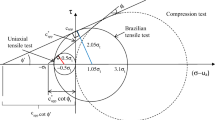Conclusions
-
1.
Analysis and experimental research have confirmed that the indirect tension method can be used to find the nominally instantaneous tensile strength of frozen ground.
-
2.
Fracture of specimens of frozen ground is accompanied by formation of compaction nuclei at load transfer points; their appearance has a greater effect on the fracture of low-saturated cohesive soils and a lesser effect on sand, ice, and waterlogged cohesive soils.
-
3.
Equation (1) can be used to determine the nominally instantaneous tensile strength for the majority of soils obeying Eq. (7). Equation (8) can be used for calculating σit for cohesive, low-saturated soils.
Similar content being viewed by others
Literature Cited
A. D. Osipov, “Determining the tensile strength of concrete”, Gidrotekh. Stroitel'., No. 8 (1956).
S. P. Timoshenko, Theory of Elasticity [in Russian], ONTI (1937).
P. J. F. Wright, “Comments on an indirect tensile test on concrete cylinders”, Magazine of Concrete Research, 7, No. 2 (1955).
Additional information
Translated from Gidrotekhnicheskoe Stroitel'stvo, No. 3, pp. 37–38, March, 1968.
Rights and permissions
About this article
Cite this article
Shloido, G.A. Determining the tensile strength of frozen ground. Hydrotechnical Construction 2, 238–240 (1968). https://doi.org/10.1007/BF02377405
Issue Date:
DOI: https://doi.org/10.1007/BF02377405



